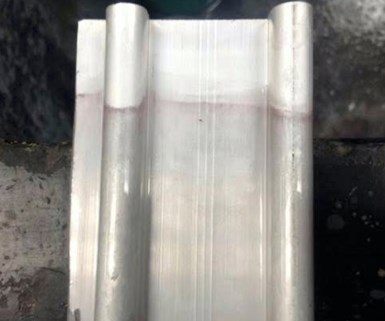Preventing Anodizing Cathodes from Turning Red
While the red color may not be desirable, anodizing expert Drew Nosti says it poses no particular problem to a successful anodizing process.
#basics #asktheexpert
Q: Why are my cathodes turning red?
A: When setting up an anodizing line, the best choice for a cathode is 6063‐T6 aluminum, which is the cathode of choice to improve conductivity for more consistent coating thickness, reduce dissolution of the cathodes and eliminate the possibility of lead contamination from lead cathodes in the waste stream. Even though the 6063 aluminum does slowly dissolve over time, the benefits far outweigh the drawbacks. Our experience indicates the 6063‐T6 aluminum cathodes last as long as two years and up to three years in an active anodizing operation.
Featured Content

Image 1: The addition of copper to the electrolyte almost immediately migrated to the aluminum 6063‐T6 cathode.
Since the move to the 6063 material for cathodes, it has come to our attention that sooner or later the aluminum cathodes may become covered with a red substance. After research on this issue, we have found that it is a coating of copper. This copper contamination is not derived primarily from the cathode, but is a result of copper dissolution from copper-containing aluminum alloys running through the anodizing process. Most aluminum alloy parts contain some percentage of copper with alloys 2024 and 7075 (the preferred choice of the aerospace industry) containing higher amounts of copper. Therefore, it is easily understood how this copper contamination arrives in solution.

Image 2: After 30 minutes, the copper has coated most of the exposed cathode.
The copper dissolved in the electrolyte immediately migrates to the aluminum cathode and is reduced to copper metal on the surface of the aluminum due to the vast difference in the electrical potential of the two elements. Because of this continuous migration and reduction of the copper, finding dissolved copper in the electrolyte is sometimes difficult or improbable. The copper migrates to the aluminum cathode with or without current and can become visible almost immediately.
As you can see in Image 1, the addition of copper to the electrolyte almost immediately migrated to the aluminum 6063‐T6 cathode. As shown in Image 2, after 30 minutes the copper has coated most of the exposed cathode.
To prevent recontamination of the electrolyte, we suggest bagging the cathode to prevent this material from sluffing off and begin to circulate in the electrolyte.
We conclude that while the red color may not be desirable, it poses no particular problem to a successful anodizing process. Because the use of 6063‐T6 aluminum as the cathode increases the transfer of electrical current, the overall results are worth the inconvenience of the red coating.
Drew Nosti, CEF, is president of Anodize USA. Joe Ciejka, head research chemist at LusterOn Products, and Steve Gilbert, national sales manager, LusterOn Products, also contributed to this article.
RELATED CONTENT
-
Techniques to Enhance UV Stability of Dye Anodized Coatings
The ultraviolet stability of anodic coatings is assessed based on lightfastness/colorfastness testing.
-
Troubleshooting the Drying Process
For some technicians who are new to spraying water coatings, it can be a huge learning curve, as the basics of reduction, spraying and drying are much different than those of the solvent world.
-
10 Anodizing Best Practices
Following this list of guidelines can help to increase the performance, cost effectiveness and quality for your anodizing operation.


















